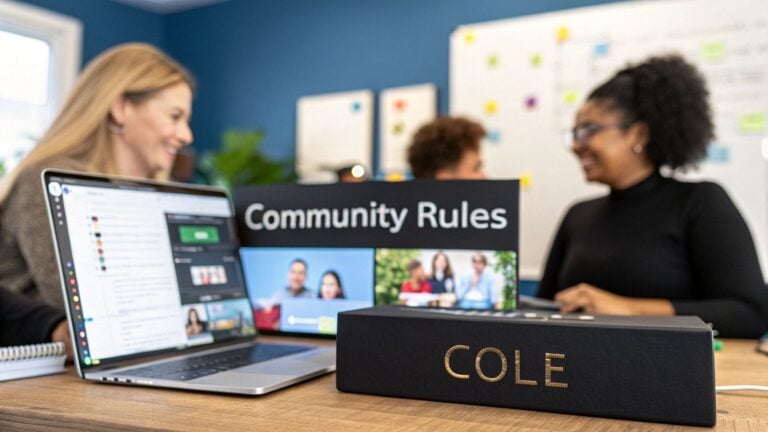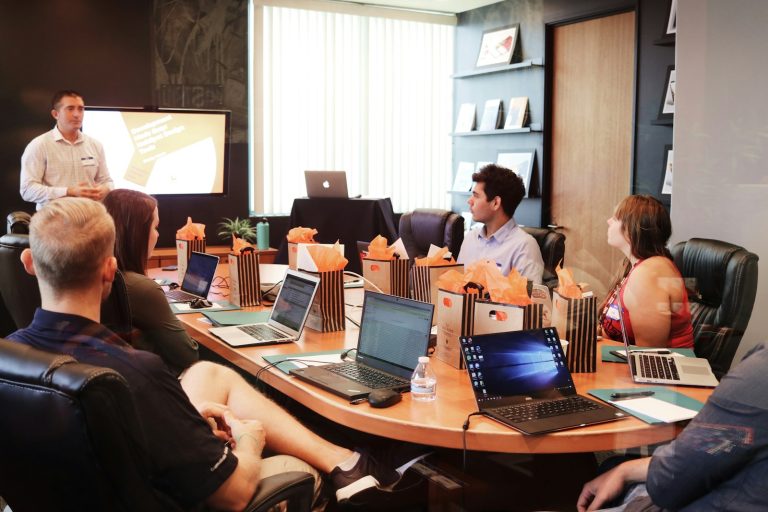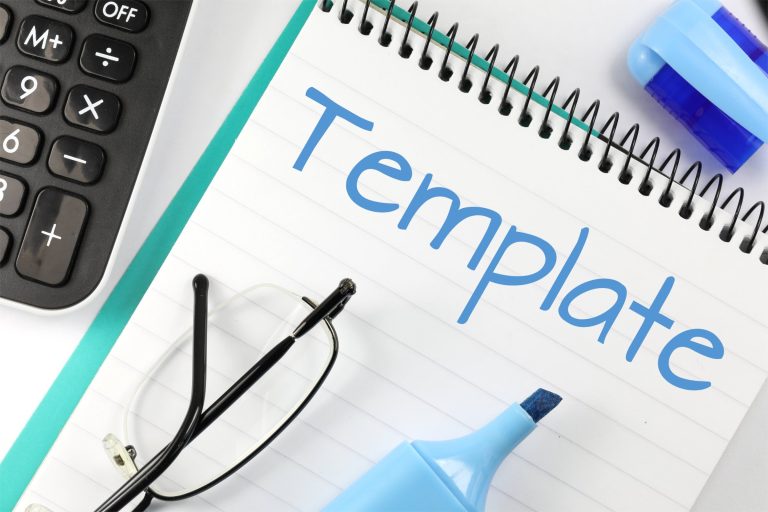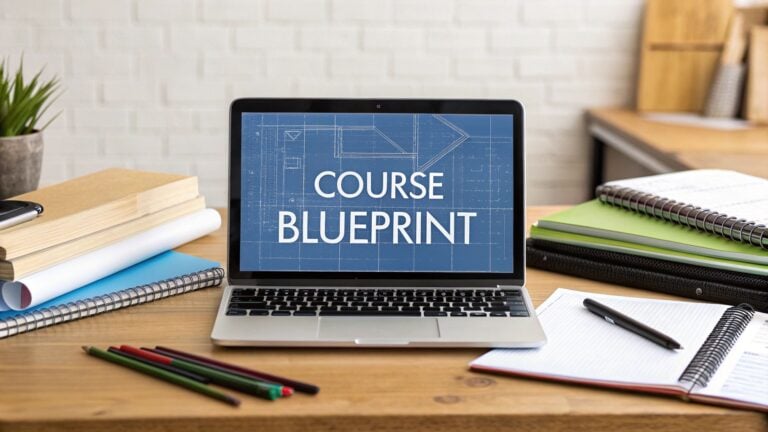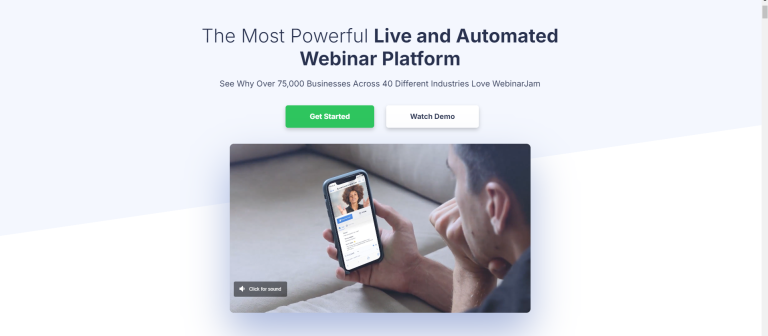Online Course Quality Assurance Done Right
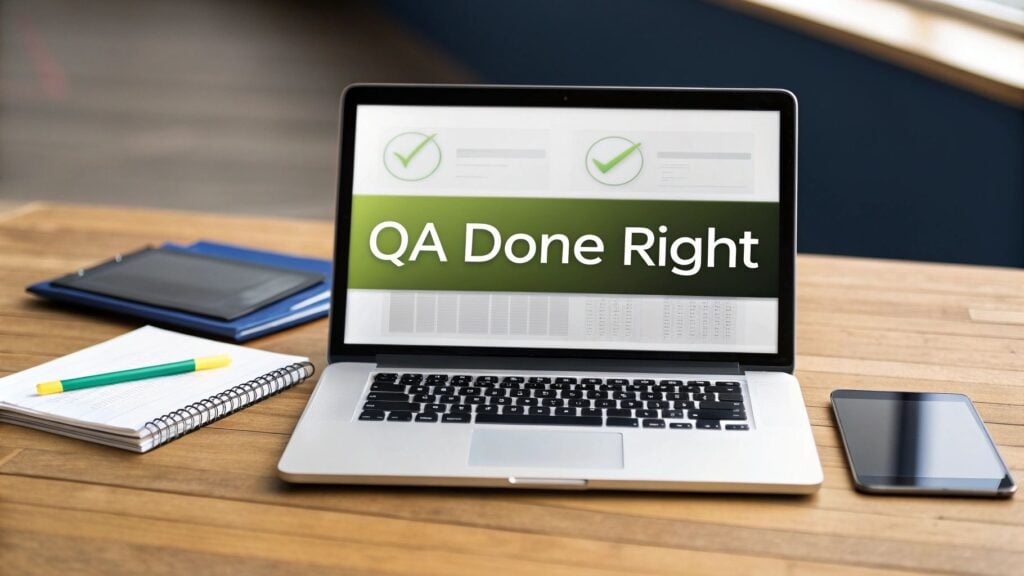
When I talk about online course quality assurance, I’m not just talking about running a spell check or fixing a couple of broken links. Of course, those little things matter. But true quality assurance goes so much deeper.
From the moment a student enrolls to the second they finish that final lesson. You’re checking everything, your content, your design, your tech, to make sure students don’t just finish. They should actually achieve their goals and feel like they made a smart investment.
What Quality Actually Means in an Online Course
Think of yourself as a guide leading a student on an expedition. A low-quality course is like a poorly marked trail with washed-out bridges and confusing maps. A high-quality one makes the entire journey feel intentional, valuable, and maybe even a little bit fun.
This is what separates a course that gets forgotten from one that gets rave reviews. It’s about building a learning journey that feels seamless and genuinely helpful.
The Core Components of a Quality Course
So, what does a “high-quality” course actually look like in practice? A folder of videos and PDFs doesn’t cut it. It’s a carefully constructed experience, and it’s built on a few non-negotiable pillars.
Here are the elements that separate the great courses from the mediocre ones:
- A Clear Learning Path: Students should always know where they are, where they’ve been, and what’s coming next. The navigation feels intuitive, not like a maze. The structure just makes sense.
- Engaging and Relevant Content: The material isn’t just factually correct. It’s presented in a way that actually holds a learner’s attention. It directly connects to the promised outcomes, using a smart mix of videos, interactive quizzes, and hands-on assignments.
- Achievable Learning Outcomes: This is the big one. Your course must deliver on its promise. If you say a student will learn to build a website, the content and activities have to lead them directly to that skill. No excuses.
- A Flawless Technical Experience: It just works. On any device. Videos load fast, quizzes don’t bug out, and downloads are always accessible. Nothing erodes trust and creates frustration faster than technical glitches.
A focus on quality from the very start can turn a simple information dump into a truly great experience that builds trust and makes students feel their time and money were well spent.
Why This Matters More Than Ever
In a ridiculously crowded market, quality is your single biggest differentiator. Anybody can upload a few videos to a platform. But creating a polished, effective, and supportive learning environment shows you actually respect your students and their goals.
A solid online course quality assurance process is your secret weapon. It helps you find the gaps, the confusing lessons, and the broken links before your students do.
Even major institutions are doubling down on this. For instance, the University of Kentucky launched a pilot program specifically to help its faculty apply quality assurance standards to their online courses. They know it’s the key to creating more effective and engaging learning.
This is the stuff that builds a rock-solid reputation, generates powerful testimonials, and turns one-time customers into loyal fans who can’t wait to see what you release next. This is an investment that pays for itself over and over again.
Building Your Quality Assurance Framework
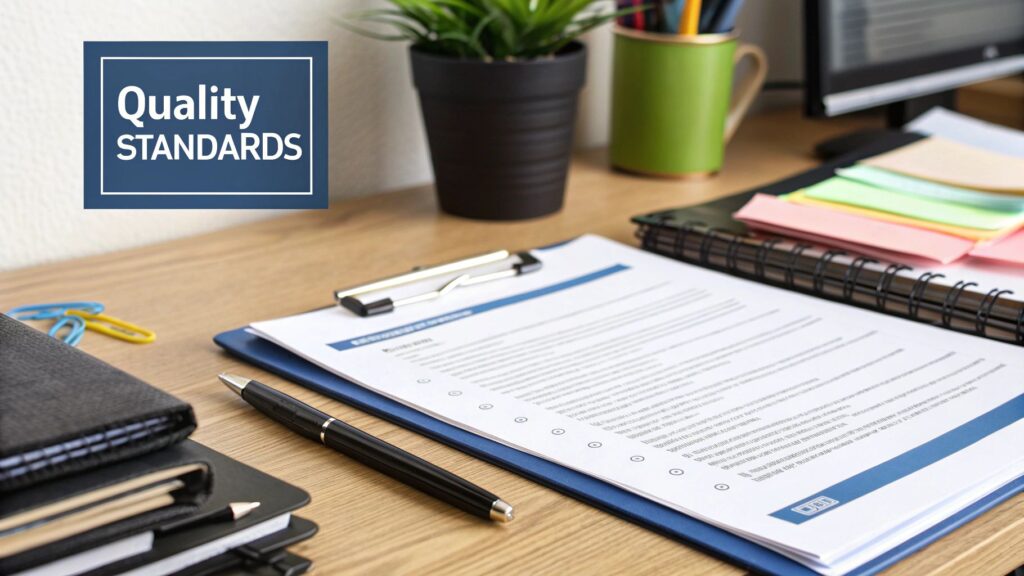
Alright, you’re ready to get serious about quality. But where do you actually start? The word “framework” can sound a little intimidating, but it’s really just your personal playbook for creating consistently great courses.
Think of it as your recipe. Instead of just tossing ingredients into a bowl and hoping for the best, you have a clear, repeatable process that leads to a fantastic result every single time. This is exactly what an online course quality assurance framework does for your content.
Whether you’re a one-person show or part of a larger team, having a solid framework means you’re not reinventing the wheel with every new launch. It makes quality a built-in feature of your process, not an afterthought you scramble to address.
The Three Pillars of Course Quality
To keep things simple and actionable, I like to break a QA framework down into three core pillars. When you focus your review on these areas, you can cover all the critical aspects of the student experience without getting lost in the weeds.
- Content Integrity: Is your material accurate, relevant, and trustworthy?
- Instructional Effectiveness: Does the course actually teach and help students hit their goals?
- Technical Performance: Does everything just work smoothly, without glitches or frustration?
These three pillars are the bedrock of your entire QA process. Let’s look at how to build a practical checklist for each one.
Pillar 1: Content Integrity Checklist
This pillar is all about the “what” of your course. You need to make sure the information you’re providing is top-notch, current, and clearly presented. Bad information can tank your reputation faster than anything else.
Ask yourself these questions during your review:
- Is the information still accurate? Hunt for outdated stats, old software versions, or facts that have been debunked.
- Are all your sources credible? If you’re citing data or linking to outside resources, double-check that they are reputable and the links aren’t dead.
- Is the content free of errors? This includes the small stuff like typos and grammatical mistakes that can make your course feel unprofessional.
Pillar 2: Instructional Effectiveness Checklist
Now we move beyond the content itself to how you teach it. This is about designing a journey that reliably guides students from where they are to where they want to be. It’s what separates a good course from a great one.
A high-quality learning experience requires a thoughtful approach. As you build your course, you need to think beyond just creating content and consider how to shape the entire customer journey. This is similar to how creating a sales funnel for membership sites requires planning each step of the user experience.
Instructional design is the art of making learning happen. Your framework ensures you’re helping students understand and apply the information, not just presenting it.
Here’s what to look for:
- Do the learning objectives match the content? If you promised students they’d learn a specific skill, is there a clear, direct path in your lessons?
- Are activities and assessments meaningful? Do quizzes, projects, and assignments actually reinforce what was taught?
- Is the pacing logical? The course should flow naturally, with each lesson building on the last. Watch out for sudden jumps in difficulty.
Pillar 3: Technical Performance Checklist
Finally, this pillar covers the actual delivery of your course. Even the best content in the world is useless if students can’t access it easily. Technical problems are a huge source of frustration and a fast track to refunds and bad reviews.
In e-commerce, focusing on this kind of performance testing led to a reported 30% reduction in website downtime during peak traffic. This lesson applies directly to online courses. Your students expect a seamless experience.
Your technical check should include:
- Cross-device compatibility: Does the course look and function perfectly on a desktop, tablet, and smartphone?
- Link and resource functionality: Click every single link. Download every file. Make sure nothing is broken or leads to a 404 error.
- Video and audio quality: Are videos crisp and easy to see? Is the audio clear and free of distracting background noise?
By building your own simple framework around these three pillars, you create a repeatable system that catches problems early. It’s your guarantee that every course you launch meets a high standard of quality that keeps students happy and engaged.
Your Step-By-Step Quality Assurance Process
Having a great framework is one thing, but bringing it to life with a practical workflow is where the magic really happens. Let’s walk through the actual steps of putting your online course quality assurance plan into action. I’ll lay out a clear path you can follow, from your first rough draft all the way through post-launch improvements.
This process will help you feel organized and in control, making sure you catch issues early and often. It turns QA from a daunting final exam into a series of manageable checkpoints.
Stage 1: The Initial Design Review
This is your first line of defense, and it happens before you’ve recorded a single video or written a single quiz question. Here, you’ll review your course outline and structure against your quality framework. It is so much easier to move a module in a document than it is to re-record and re-edit an entire section later on.
During this stage, you’re looking at the big picture.
- Logical Flow: Does the course structure actually make sense? Does each module build logically on the one before it?
- Objective Alignment: Does every proposed lesson, activity, and resource directly support one of your main learning outcomes? No fluff.
- Completeness: Are there any obvious gaps in the content? Is anything missing that students will absolutely need to succeed?
This initial check saves you countless hours down the road by making sure your blueprint is solid before you start building.
Stage 2: Alpha Testing with Your Internal Team
Once you have a working draft of your course, it’s time for alpha testing. This is your internal review. If you’re a solo creator, this might just be you going through everything with a fresh, critical eye. If you have a team, get them involved.
The goal here is to catch the most obvious and glaring issues. You’re not looking for student feedback yet, you’re looking for things that are flat-out broken.
Think of alpha testing as the dress rehearsal before opening night. It’s your chance to fix the set and make sure all the props work before the audience arrives.
Your team should be hunting for technical glitches, typos, broken links, and confusing instructions. They are your first users, and their job is to find anything that could trip up a real student. This phase cleans up the course so that when you get it in front of learners, they can focus on the content, not the bugs.
To formalize this process, many are turning to established standards. For instance, the United Nations Statistics Division (UNSD) implemented a self-paced e-learning course to train statisticians on data quality. This is a core part of evaluating online education.
This shows a global trend toward institutionalizing quality assurance in digital learning. You can learn more about the UNSD’s approach to data quality.
This simple process flow visualizes how these stages connect to create a continuous improvement cycle.
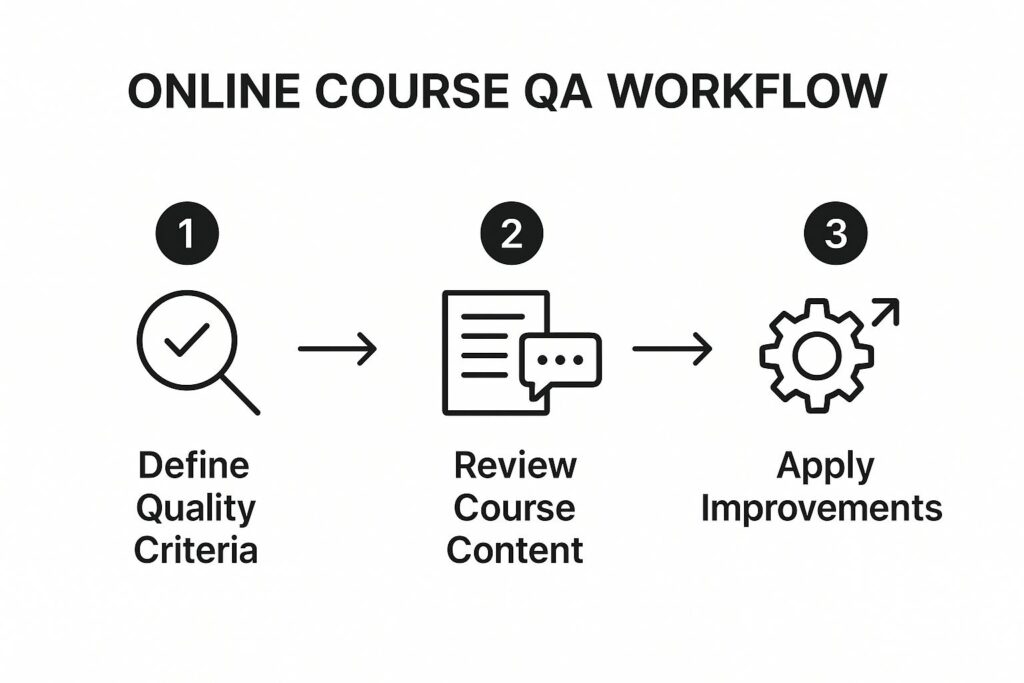
Defining your criteria first gives you a clear target, while the review and improvement stages ensure you consistently hit that mark.
Stage 3: Beta Testing with Real Learners
Now for the most valuable part of the process: beta testing. This is where you invite a small, select group of actual learners to go through your course before you launch it to the public. Their feedback is pure gold.
You’re not just looking for bugs anymore. You’re looking for candid feedback on the entire learning experience.
Tips for a Successful Beta Test:
Choose the Right Testers: Find people who represent your ideal student. A mix of beginners and more advanced learners can give a well-rounded perspective.
Give Clear Instructions: Don’t just ask them to “take a look.” Tell them exactly what kind of feedback you’re looking for. Ask specific questions like, “Was Lesson 3 clear?” or “Did the quiz for Module 2 feel fair and relevant?”
Use a Feedback Form: Don’t just ask for an email with their “thoughts.” Create a structured survey or form that guides them to provide specific, actionable insights on content clarity, pacing, and engagement.
This final step gives you the confidence to launch, knowing your course has been tested and refined by the very people you created it for. It’s the last checkpoint in your online course quality assurance journey.
How to Measure Your Course Quality
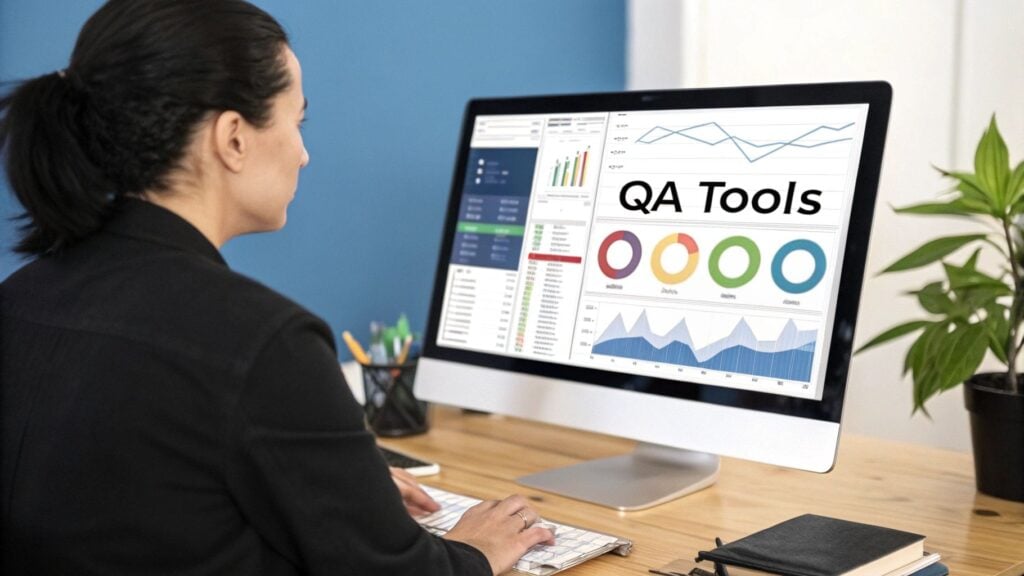
You can’t improve what you don’t measure. After all the hard work building and testing your course, you need a way to know if it’s actually working. How do you find out if your learners are not just finishing the material but are truly getting value from it?
This is where the right metrics come in. By tracking the right data, you get a clear, honest picture of what’s hitting the mark and what needs a little more attention. It’s the key to making smart, informed improvements that directly boost your students’ success.
Moving Beyond Simple Completion Rates
The first metric most people look at is the completion rate. This is the percentage of students who make it to the end. While it’s a useful number, it doesn’t tell the whole story. A student could just click through every video and quiz to get it done without actually learning anything.
That’s why digging into the nuances of online course quality assurance requires a broader set of data. Low completion rates can definitely signal a problem, but a high rate doesn’t automatically mean your course is a masterpiece. For a deeper look, you can explore what the average online course completion rate is and why it matters in our other guide.
To get a real sense of quality, we need to look at metrics that measure satisfaction, understanding, and genuine engagement.
Key Metrics for Deeper Insights
If you want to truly understand your course’s performance, you have to combine different types of data. I like to focus on a few key areas that paint a more complete picture of the learner experience.
Here are the metrics I find most valuable:
Learner Satisfaction Scores: This is the most direct way to measure how students feel about your course. You can use tools like a Net Promoter Score (NPS) survey, which simply asks how likely they are to recommend your course to a friend.
Assessment Pass Rates: This shows you how many students are successfully passing your quizzes, assignments, and exams. It’s a powerful indicator of whether your teaching methods are effective and your content is clear.
Engagement Analytics: This data reveals how learners are interacting with your course materials. Are they re-watching certain videos? How active are they in the discussion forums? High engagement is a fantastic sign of a healthy course.
Think of these metrics as your course’s health report. Each one tells you something different, but together, they give you a comprehensive diagnosis of its overall quality.
How to Interpret Your Data and Take Action
Collecting data is only half the battle. The real value comes from interpreting it correctly and using those insights to make your course better. You’re looking for patterns that tell a story.
For example, if an entire group of students gets stuck on the same quiz question, the problem probably isn’t the students. It’s likely an issue with the question itself or the lesson that was supposed to teach that concept.
To make sense of it all, it helps to organize your metrics and understand what each one is really telling you.
Key Metrics for Online Course Quality
Here’s a breakdown of the essential metrics, what they measure, and why they are so important for your quality assurance process.
| Metric | What It Measures | Why It Matters |
|---|---|---|
| Learner Satisfaction | Student happiness and perceived value | High scores lead to better testimonials, referrals, and word-of-mouth growth. |
| Assessment Pass Rate | Content comprehension and clarity | Low pass rates signal confusing content or unclear teaching that needs to be revised. |
| Engagement Levels | Student interest and active participation | Active discussions and high interaction show that learners are invested in the material. |
By regularly reviewing these numbers, your online course quality assurance stops being a one-time checklist and becomes a continuous cycle of improvement. You can spot a problem, fix it, and then measure again to see if your changes made a positive difference. This data-driven approach is what allows you to refine your course over time, ensuring it delivers an outstanding experience for every student who enrolls.
Learning from Industry Quality Standards

To really level up your course quality assurance, you don’t have to start from scratch. Plenty of other industries have spent decades perfecting quality management, and we can borrow their best ideas for our own online courses.
Frameworks like ISO 9001 might sound overly corporate or complicated, but the principles behind them are pure gold. You don’t need to chase a formal certification. The goal is adopting a professional mindset that’s been proven to get exceptional results time and time again.
Core Principles You Can Use Today
At their heart, these big-name standards boil down to a few powerful ideas. They’re all about creating systems that consistently produce great outcomes. Let’s look at a couple you can put to work for your courses right away.
First up is a relentless focus on the customer, or in our case, the learner. This means every single decision, from the course outline to the final quiz, should be made with your student’s needs and goals front and center. It’s about seeing your course through their eyes.
Another key idea is process consistency. This just means having a repeatable, documented way of doing things. When you have a clear process for designing, reviewing, and updating your courses, you slash errors and ensure every course you create meets a high standard of excellence.
The Power of Continuous Improvement
Perhaps the most important lesson we can take from these standards is the commitment to continuous improvement. Your course is never truly “done.” It’s a living, breathing project that can always be made better.
This mindset pushes you to constantly seek feedback, analyze your metrics, and look for small ways to refine the learning experience. This is what separates good course creators from the great ones.
Adopting a mindset of continuous improvement turns your quality assurance from a one-time task into an ongoing habit. It ensures your course stays relevant, effective, and valuable for years to come.
We’re seeing a major shift in online course QA toward integrating these internationally recognized standards, like ISO 9001:2015, which sets strict criteria for Quality Management Systems.
In fact, platforms like Udemy now offer courses on becoming an auditor for these systems, showing just how valuable this skillset has become. You can discover more insights about these quality assurance courses and see how they are shaping the industry.
Making It Practical for Your Courses
So, how do you actually put this into practice? Start by creating a simple checklist based on your ideal learner’s needs. Think about what a successful student journey looks like from the moment they enroll to the day they graduate.
Next, document your creation and review process. Even a simple one-page guide can work wonders for staying consistent. For example, our guide on building a competency-based training framework can give you some great ideas on how to structure your content with clear, measurable goals in mind. Check out our guide on building a competency-based training framework to get started.
By borrowing from established industry standards, you professionalize your entire approach. You build a system that doesn’t just catch mistakes but actively prevents them, leading to a much better experience for your learners and a stronger reputation for you.
What Top-Tier Course Quality Actually Looks Like
Theory is one thing, but seeing quality in action is what makes it all click. To really get a feel for what excellent online course quality assurance looks like, we need to look at the platforms that have staked their entire reputation on it. I’m talking about the major players who manage thousands of courses and still somehow maintain an incredibly high standard.
Let’s pull back the curtain on a platform like Coursera. They aren’t just getting lucky. They’ve built intentional, robust systems to make sure every single course meets a specific quality bar before a student ever clicks “enroll.”
Rigorous Vetting and Clear Pathways
The first thing you’ll notice with the best platforms is how seriously they take their instructor and course vetting. Before any course goes live, it’s put through a rigorous review process. This is a deep dive to ensure the instructor is a genuine expert and that the content flows in a way that makes sense. It isn’t just a spell-check.
They’re obsessed with creating clear learning pathways. A student should never feel lost or wonder what to do next. From the syllabus all the way down to individual lesson descriptions, every step is designed to guide the learner forward, building their momentum and confidence along the way.
This initial vetting process acts as the first and most important quality gate. By setting a high bar from the very beginning, platforms prevent low-quality content from ever polluting their ecosystem, which builds immense trust with learners.
This commitment to quality isn’t just a nice-to-have. It’s a core part of their business model that directly fuels growth and keeps students coming back for more.
Turning Learner Feedback into a Flywheel for Improvement
Another powerhouse strategy these platforms use is the systematic collection and application of student feedback. They don’t just ask for a generic star rating at the end. Instead, they build feedback loops directly into the learning experience, prompting for reviews on individual modules or even specific videos.
This creates a constant, real-time stream of data that helps instructors and the platform itself see what’s landing and what’s falling flat. If dozens of students flag a particular video as confusing, that’s a clear signal that something needs to be reworked. This approach transforms quality assurance from a one-time check into a living, breathing process of constant improvement.
The demand for these high standards is obvious. In fact, the growth of online courses about quality assurance itself shows just how much learners value it. Coursera hosts a ton of courses on software quality assurance and process optimization.
These are the very skills needed to build reliable online platforms. These courses often rack up hundreds of student reviews, demonstrating a global appetite for mastering quality. You can explore a variety of quality assurance courses on Coursera to see this trend for yourself.
Nailing the Technical Experience
Finally, the best platforms are absolutely obsessed with the technical side of things. They understand that even the most brilliant content becomes useless if the video player is buggy, the site is slow, or it doesn’t work on a smartphone. Their QA process involves exhaustive testing across countless devices, browsers, and internet speeds.
They invest heavily to make sure the platform is stable, fast, and feels intuitive.
Here are a few technical checks they simply never skip:
- Mobile Responsiveness: They make sure every single element of the course, from videos to quizzes, works flawlessly on a small screen.
- Performance and Load Times: Videos have to start instantly, and pages must load without any frustrating lag.
- Accessibility: They adhere to strict standards to ensure learners with disabilities can fully access and participate in every course.
By studying how these real-world giants operate, you can borrow proven strategies for your own projects. Their success is proof that a deep, unwavering commitment to online course quality assurance is the foundation for building an educational experience that students genuinely love and trust.
Your Top QA Questions, Answered
As we get to the end of this guide, let’s tackle a few of the practical, “how does this actually work?” questions that always come up. Think of this as the FAQ section for when the rubber meets the road. Getting these things straight will help you move forward with a lot more confidence.
Let’s dive in.
How Much Time Should I Actually Spend on QA?
This is the big one, and honestly, there’s no single magic number. But after years of doing this, I’ve found a solid rule of thumb: set aside 15-20% of your total course creation time just for testing and review.
So, if you spend 100 hours building your course from scripting videos to designing worksheets, plan to spend at least 15 of those hours on pure, focused QA.
I know, it sounds like a lot. But every minute spent here is a direct investment in your students’ happiness and your long-term reputation. Catching a broken link before a student does is always, always worth it.
What’s the Real Difference Between Alpha and Beta Testing?
People throw these terms around, sometimes interchangeably, but they are two very different and equally critical stages of your QA process. The easiest way to think about it is like putting on a stage play.
Alpha Testing: This is the dress rehearsal with just the cast and crew. It’s your internal review, done by you, your assistant, or your team. The goal here is to find all the obvious, technical glitches. The broken links, the video that won’t load, the glaring typos.
Beta Testing: This is the preview performance for a small, invited audience. You bring in a select group of real learners to go through the course and give you feedback on the entire experience before you open the doors to the public.
Alpha testing fixes the stuff that’s broken. Beta testing tells you if the experience is actually any good. You absolutely need both to create a polished, professional course.
You can’t get an honest student perspective from your own internal review. Beta testing is the only way to truly see your course through a fresh pair of eyes before it goes live.
Can I Do QA if I’m a Solo Creator?
Absolutely. In fact, you have to. Being a one-person show just means you need to be a little more strategic about it.
You’ll naturally be your own first-pass alpha tester. That means you’re the one clicking every link, watching every video, and reading every word of your own material. But for that all-important beta feedback, you’ve got to look outside your own head.
Try swapping courses with another creator in your niche for a review exchange, it’s a win-win.
You could also ask a trusted friend or even a past student who perfectly fits your ideal learner profile. Getting feedback from just one or two other people is infinitely better than flying blind. They will spot things you’re completely oblivious to, guaranteed.

